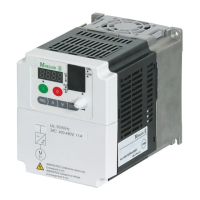Programming the control
signal terminals
09/01 AWB8230-1412GB
50
EXT 12 External fault When the EXT input is switched on, the fault signal activates PNU E12 and the motor switches off.
The fault signal can be acknowledged, for example, with the RST input.
USP 13 Restart inhibit
When the USP input is switched on, the restart inhibit is active. This prevents a motor restart when
the voltage recovers after a mains failure while a start signal is present.
SFT 15 Parameter protection
Switching on the SFT input to activate the parameter protection prevents loss of the entered para-
meters by inhibiting write operations to these parameters.
AT 16 Setpoint input OI (4 to
20 mA) active
When the AT input is switched on, only the setpoint value input OI (4 to 20 mA) is processed.
RST 18 Reset
To acknowledge an error message, switch on the RST input. If a reset is initiated during operation,
the motor will coast to a stop. The RST input is a make (NO) contact; it cannot be programmed as
a break contact (NC).
PTC 19 Connection for a PTC
thermistor
You can only program digital input 5 with PNU C05 as an input for a PTC thermistor. Use terminal
L as the reference potential.
P24 – +24 V H for digital
inputs
24 V H potential for digital inputs 1 to 5
Frequency setpoint definition
h – +10 V setpoint voltage
for external potentio-
meter
Setpoint value can be set with
potentiometer:
Setpoint value through voltage
input:
Setpoint value through
current input:
O – Analog input for
frequency setpoint
(0 to +10 V)
OI – Analog input for
frequency setpoint
(4 to 20 mA)
R: 1 to 10 kO 0 to 10 V H
Input impedance: 10 kO
4 to 20 mA H
Load resistor: 250 O
L – 0 V reference potential
for setpoint inputs
The OI input for a setpoint value from 4 to 20 mA is only used when the digital input configured
as the AT input is closed.
analog output
FM – Frequency monitor The frequency can be output via a connected analog or digital measurement device via this input.
As an option, the motor current can be displayed.
L – 0V
0 V reference potential for the FM output
Name Value
1)
Function Description
LOIOH
PES
LOIO
–
+
PES
LOI
–
+
PES

